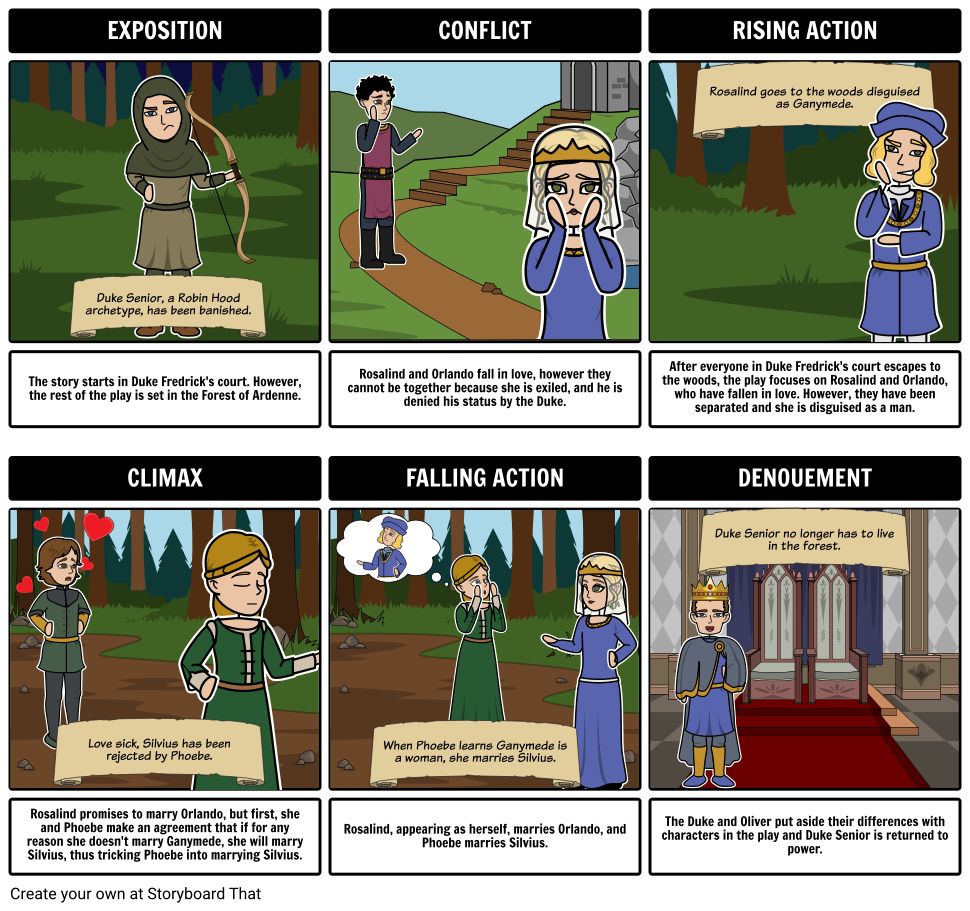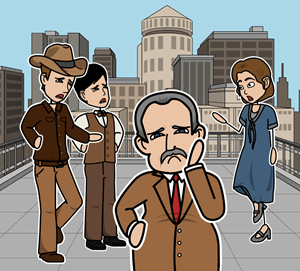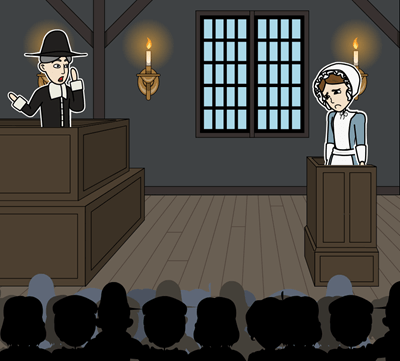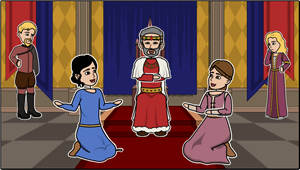Five Act Structure: The Dramatic Structure
Plays have been a popular form of entertainment since ancient Greece. One significant element in playwriting is the utilization of a formal plot structure, offering a clear and organized framework for shaping the structure of a play. Structuring is essential for writers to create a cohesive plot with well-defined plot points and character arcs and as such, acts are essential to explain plot structure in drama. There are two main types of dramatic structures used to characterize plays. Aristotle was one of the first to write about drama and describe its three segments: beginning, middle, and end. Over time, dramas evolved, the Roman poet, Horace advocated for five acts, and many centuries later, a German playwright, Gustav Freytag, developed the 5-act play structure commonly used today to analyze classical and Shakespearean dramas. The 5-act and three-act structures, which represent distinct parts of a play, serve as fundamental frameworks that can be observed in plays across all literary genres, from mysteries to contemporary novels, science fiction, classical dramas or even tragedy. Structure provides a fundamental blueprint for organizing the progression of narrative events. The pattern of this 5-act story structure can be seen in the familiar plot diagram called Freytag's pyramid, also known as the dramatic arc. It is a visual representation of a 5-act play that shows the structure of the plot in terms of exposition, rising action, climax, falling action, and resolution:

The Three Act Structure
Aristotle believed that every piece of poetry or drama must have a beginning, middle and end. These divisions were developed by the Roman, Aelius Donatus, and called Protasis, Epitasis, and Catastrophe. The three-act story structure has seen a revival in recent years, as cinema blockbusters and hit TV shows have adopted it.
The Five Act Structure
The five act structure expands the classical divisions and can be overlaid on a traditional plot diagram, as it follows the same five parts. Shakespearean plays especially are known for following this structure. In the illustration above, the narrative arc of the Plot Diagram is between the Five Act Structure (top) and Aristotle’s divisions (bottom).
Format of a Five Act Plot Structure
Act One: The Exposition
Here, the audience learns the setting (time/place), characters are developed, and a conflict is presented, usually with the introduction of some form of exciting force. An exciting force or what can be referred to as an inciting incident can be in the form of an event or circumstance that disrupts the status quo and sets the plot in motion, leading the protagonist to take action and begin their journey of self-discovery.
Act Two: Rising Action
The action of this act leads the audience to the climax. It is common for complications to arise, or for the protagonist to encounter obstacles.
Act Three: The Climax
This is the turning point of the play. Acts often culminate in the climax, characterized by the highest amount of suspense.
Act Four: Falling Action
Falling action is the part of a play where the conflict that was introduced in the rising action begins to unravel and the tension starts to dissipate. During this stage, the protagonist's struggles are often resolved, and the audience can begin to see the consequences of their actions.
Act Five: Denouement or Resolution
This is the final outcome of the drama. Here the author's tone about his or her subject matter is revealed, and sometimes a moral or lesson is learned.
How to Write Five-Act Structures
- Identify the Key Plot Points: Begin by identifying the main events that will shape the story, such as the inciting incident, the climax, and the resolution.
- Divide the Story Into Five Acts: Divide the story into five parts: the introduction, rising action, climax, falling action, and resolution.
- Set the Stage: The introduction should establish the setting and introduce the main characters, while also setting up the main part of the story where complications arise. In the first half of the play, the audience is introduced to the main characters and the initial conflict, setting the stage for the unfolding drama. In the second half, the story intensifies, presenting greater challenges and pushing the narrative to its climax.
- Build the Tension: In the rising action, the protagonist should face increasingly difficult obstacles that raise the stakes and create tension for the audience.
- Reach the Climax: The main climatic moment is the turning point of the story, where the protagonist must confront the main conflict and make a crucial decision.
- Begin the Resolution: The falling action should provide a sense of closure and begin to tie up loose ends from the story.
- Bring the Story to a Close: In the resolution, the protagonist should achieve some form of resolution, either positive or negative, that provides a sense of closure for the audience.
- Edit and Revise: Once the story is complete, revise and edit the structure as needed to ensure that the story flows smoothly and the dramatic structure is effectively employed.
By following these steps, you can create a five-act dramatic structure that effectively engages your audience and provides a compelling narrative.
Examples of the Five Act Structure with Shakespeare's Plays
Romeo and Juliet, one of Shakespeare's most well-known plays, serves as a good example of the five-act structure. By using Freytag's pyramid to analyze the plot, we can see how the play's events unfold and identify the key plot points that drive the story forward.
Romeo and Juliet
Romeo and Juliet, one of Shakespeare's most well-known plays, serves as a good example of the 5-act structure. By using the Freytag pyramid to analyze the plot, we can see how the play's events unfold and identify the key plot points that drive the story forward.

Act 1: The Exposition
- Setting: Verona Italy, 16th or 17th century
- Characters: Capulets and Montagues, specifically, Romeo and Juliet
- Conflict: The Montagues and Capulets are feuding
Act 2: Rising Action
- Romeo and Juliet fall in love but cannot be together because their families do not like each other. They decide to get married in secret.
Act 3: The Climax
- After crashing the Capulet party, Tybalt goes after the Montague crew and kills Mercutio.
- To avenge his friend, Romeo duels with and kills Tybalt - Juliet's cousin.
- Romeo is banished, but before he goes he gives Juliet a proper wedding night!
Act 4: Falling Action
- Juliet’s parents arrange a marriage for her to Paris.
- She and the Friar have an elaborate plan to get her out of a second marriage by faking her death. Part of this plan is that Romeo will receive a letter saying she’s not dead.
- Romeo - never having received the letter - thinks Juliet has died (see our article on dramatic irony).
- Romeo buys poison and goes to her tomb to commit suicide.
Act 5: Denouement or Resolution
- Romeo confronts Paris at Juliet’s tomb, and slays him before taking his own life.
- Juliet awakens from her sleeping potion to see Romeo has committed suicide.
- She takes his dagger and kills herself.
- The Friar and Nurse explain to the Capulet and Montague families that the two lovers were married in secret.
- Both families are saddened by the situation, and vow to end their long-standing feud.
As You Like It
As You Like It, a pastoral comedy by William Shakespeare, is an exemplary story type that follows the five-act structure.

Act 1: The Exposition
- Setting: France, the story starts in Duke Fredrick's court, however, the rest of the play is set in the Forest of Ardenne.
- Characters: Duke Frederick, Duke Senior, Rosiland, Celia, Orlando, Oliver, Touchstone, and Jaques
- Conflict: Duke Frederick has exiled his brother, Duke Senior, to the forest. His daughter, Rosiland is banished shortly thereafter. Orlando must escape the persecutions of his older brother, Oliver.
Act 2: Rising Action
- Rosalind disguises herself as young man, Ganymede.
- There is a great deal of mistaken identity in the forest, and many characters fall in love with people who do not love them.
Act 3: The Climax
- Rosalind/Ganymede craftily arranges a set of promises to make sure everyone will get married, and no one will be disappointed.
- Rosalind then reveals her true identity to the other characters.
Act 4: Falling Action
- Orlando saves his brother from a lion, and the two are reconciled. Oliver falls in love with Aliena.
- There is a giant wedding for all of the couples.
Act 5: Denouement or Resolution
- All of the characters, except Frederick and Jacques, who become religious hermits, return to the dukedom.
Macbeth: “The Scottish Play”
 Macbeth 5 Act Structure - Play Acts - 5 act story structure" width="1932" height="447" />
Macbeth 5 Act Structure - Play Acts - 5 act story structure" width="1932" height="447" />
Act 1: The Exposition
- Setting: Scotland, at the end of a war
- Characters: Macbeth and his friend Banquo are introduced.
- Conflict: Three witches have brewed an evil plot involving Macbeth, and they tell him that he will be king!
Act 2: Rising Action
- Macbeth and his wife kill the King and take the throne.
- They go on a tyrannical killing spree. The action rises as the audience sees how ambitious Macbeth and Lady Macbeth have become.
Act 3: The Climax
- Macbeth holds a banquet and sees the ghost of Banquo (who Macbeth had killed).
- Lady Macbeth becomes mentally unstable, and the couple begins to fear the consequences of their murderous deeds.
Act 4: Falling Action
- A rebellion is instigated by Macduff to restore the throne to Duncan's exiled son.
- Macbeth learns another set of prophecies from the witches and begins to think he will be saved.
Act 5: Denouement or Resolution
- The three witches’ predictions come true, and the castle is stormed. Macbeth is killed.
Related Activities
Check out some pre-made activities that you can use in your classroom today!
Five Act Structure

View Activity
Five Act Structure

View Activity
Five Act Structure

View Activity
Common Core Standards
- ELA-Literacy.RL.6.2: Determine a theme or central idea of a text and how it is conveyed through particular details; provide a summary of the text distinct from personal opinions or judgments
- ELA-Literacy.RL.7.2: Determine a theme or central idea of a text and analyze its development over the course of the text; provide an objective summary of the text
- ELA-Literacy.RL.8.2: Determine a theme or central idea of a text and analyze its development over the course of the text, including its relationship to the characters, setting, and plot; provide an objective summary of the text
- ELA-Literacy.RL.9-10.2: Determine a theme or central idea of a text and analyze in detail its development over the course of the text, including how it emerges and is shaped and refined by specific details; provide an objective summary of the text
- ELA-Literacy.RL.11-12.2: Determine two or more themes or central ideas of a text and analyze their development over the course of the text, including how they interact and build on one another to produce a complex account; provide an objective summary of the text
Related Resources
- Picture Encyclopedia of Shakespeare Plays
- Literary Genres: Types and Examples
- Teaching Narrative Structure
- Tragedy of Romeo and Juliet
How to Connect Five-Act Structure to Theme and Character Development
Introduce the Five-Act Structure
Provide a brief overview of the five-act structure, explaining that it is a narrative framework commonly used in plays, literature, and films.
Define Theme and Character Development
Define theme as the central idea or message explored in a story, and character development as the process of how characters change and evolve throughout the narrative.
Identify Themes
Guide students in identifying the themes present in the text or story they are studying. Encourage them to consider the big ideas, moral lessons, or recurring concepts that emerge throughout the narrative.
Analyze Five Acts
Break down the story into its five acts, identifying the major plot points and events in each act. Discuss how each act contributes to the overall development of the story and the progression of the characters.
Connects Acts to Theme
Analyze how each act contributes to the exploration of the identified themes. Discuss how the events, conflicts, and resolutions in each act shed light on the theme and deepen our understanding of it.
Examine Character Development
Explore how the characters change and evolve throughout the story, focusing on their motivations, conflicts, and growth. Connect the character development to the events and conflicts within each act, discussing how the characters' experiences contribute to the theme.
Frequently Asked Questions about The Five Act Play (Dramatic Structure)
What is the five act structure in a play?
The 5-act structure is a format of dramatic structure commonly used in classical and Shakespearean dramas. It expands the three-act structure by dividing the narrative into five parts: exposition, rising action, climax, falling action, and resolution.
What is the origin of the five act structure?
The 5-act structure was developed by the Roman poet Horace and later used by Gustav Freytag to analyze classical and Shakespearean dramas.
What is the purpose of the exposition in the five act structure?
The exposition is the first act in the 5 act structure. Its purpose is to introduce the setting, develop the characters, and present the main conflict of the play to the audience.
What is the difference between the rising and falling action in the five act structure?
The rising action is the second act and eventually leads the audience to the climax. It often involves complications and obstacles for the protagonist. So what does rising action mean in the context of a play? It is all about the tension and emotions created. Without rising movement, the climax would lack the necessary buildup and impact, and the falling action and resolution would not have the same emotional impact.
It occurs in the fourth act, where the story is coming to an end, and any unknown details or plot twists are revealed and wrapped up. So what does this mean in the context of a play? It is the opposite of Rising Action, whereby the story is coming to an end, and any unknown details or plot twists are revealed and wrapped up in a moment of final suspense.
What is an act in a play?
An "act" in a play is a major segment that helps organize the story, with each act containing a series of scenes to develop the plot and characters. It marks significant shifts in the narrative and can vary in number, commonly being 3 or 5 acts. The concept of 'act definition,' theater-specific terminology, is instrumental in the organization and structuring of a play, with each act representing a significant division that contributes to character development, plot progression, and the overall theatrical experience.
What is dramatic structure?
Dramatic structure is the overarching term that encompasses the design and organization of a narrative in dramatic works. It provides the essential framework for how the story unfolds, guiding the pacing and emotional arc of the plot. It outlines how the story is presented and unfolds, including key elements of the five-act structure. Dramatic structure examples, such as the three-act and five-act models, provide writers with tried-and-true frameworks to craft compelling narratives, while also allowing room for creative innovation.
Why is a 5 act structure used?
The 5-act structure is a dramatic structure commonly used in storytelling, particularly in plays and films. While the more traditional structure for many centuries was the three-act structure (beginning, middle, and end), the 5-act structure provides a more detailed and nuanced approach to storytelling. Here are some reasons why the 5-act structure is used:
- Increased Complexity: The additional acts allow for more complexity and depth in the development of the plot and characters. This can be especially useful for stories with multiple subplots or intricate narratives.
- Rising Action and Climax: The 5-act structure often includes a distinct rising action leading up to the climax, providing a more gradual build-up of tension and suspense. This can enhance the emotional impact of the story.
- Character Arcs: With more acts, there's more room for the development of character arcs. Characters can undergo significant changes, face challenges, and experience growth over the course of the five acts.
- Pacing Control:The 5-act structure allows for more precise control over the pacing of the story. Each act can serve a specific purpose and contribute to the overall flow of the narrative.





 Macbeth 5 Act Structure - Play Acts - 5 act story structure" width="1932" height="447" />
Macbeth 5 Act Structure - Play Acts - 5 act story structure" width="1932" height="447" />

